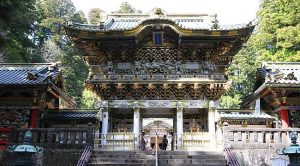The iPhone has many interesting emojis, new emojis will come up with every update. One of my best friends is a crazy fan of iPhone emojis. She always likes to send me a lot of emojis instead typing. If you use emoji, you will know there are some monkey images. One monkey covers its eyes, one covers its ears and one covers its month. It is interesting, right? But do you know where these three emojis come from?
A. From the brainstorming of Apple stuff
B. From one of the Japanese shrines
C. Emoji fans contribution
D. ET’s creation
I will choose B.

https://cdn.shopify.com/s/files/1/1061/1924/files/Hear_No_Evil_Monkey_Emoji.png?9898922749706957214

https://cdn.shopify.com/s/files/1/1061/1924/products/See_No_Evil_Monkey_Emoji_large.png?v=1480481037

https://cdn.shopify.com/s/files/1/1061/1924/products/Speak_No_Evil_Monkey_Emoji_grande.png?v=1480481037
There are a lot of shrines in Japan with a large number of followers, which shows that the shrine has the great power among Japanese population and they are also one of the distinctive nationalities in Japan. The religious activities of the local shrine are the core and mainstream of Japanese traditional culture and play an irreplaceable role in the production and life of ordinary people. The Shinto shrine is the carrier of Shinto that to house one or more kami. It contains the essence of Japanese history, culture, and religion. Shinto in Japan originated from “animism” and Shinto does not take the form of thought or the classics, but roots into customs and habits in the Japanese population.

https://upload.wikimedia.org/wikipedia/commons/a/a3/Shinto_torii_vermillion.png

http://img.mp.sohu.com/upload/20170613/ef53abed8f864eacb89a2a37ed382aee_th.png
Fushimi Inari Taisha
Fushimi Inari Taisha is the head shrine of the god Inari, which was built in 8 century, located in the Fushimi mountain in Kyoto. It is also one of the oldest shrines in Kyoto. In Japanese culture, Inari is the kami (god) of agriculture and business. Therefore, in ancient Japan, peasants come here to pray for good weather for the crops and a good harvest; merchants come to here to pray for success and wealth.
The most famous architecture of Fushimi Inari Taisha is the Senbon Torii (Japanese style pavilion). Originating in the customs of the Edo period, those who come here often make donations to erect a Torii in the Shinto shrine to express their respect for the gods, so that an amazing number of Torii houses are erected within the scope of the Fushimi Inari Shrine. Japan has believed that the fox has been sent by the Inari god through ancient times. Therefore, the fox is the messenger of Inari god, and people can see the statue of fox everywhere in the Fushimi Inari Taisha.

http://img.mp.sohu.com/upload/20170613/90ddb74283e74e38adab21e7e1877256_th.png

Messager Fox
https://media-cdn.tripadvisor.com/media/photo-s/0f/21/7b/a1/fox-in-fushimi-inari.jpg

https://thetruejapan-zezmjzde7jzkm4d76c6.netdna-ssl.com/wp-content/uploads/2017/01/Fushimi-Inari-Shrine-Romon-Gate.jpg

Senbon Torii
https://thetruejapan-zezmjzde7jzkm4d76c6.netdna-ssl.com/wp-content/uploads/2017/01/Fushimi-Inari-Shrine-Torii-Gates-Curve.jpg
Itsukushima Shrine
Itsukushima Shrine, established around 593, is a shrine located on Itsukushima Island in Hatsukaichi, Hiroshima Prefecture. It mainly hosts three goddesses of the sea in Japan’s ancient legend. Itsukushima Shrine is built in the intertidal zone of the Seto Inland Sea and the large tree stands in front of the shrine in one of the most famous landmarks of the island of Itsukushima, known as one of the “Three Sights of Japan.” The Torii gate is also known as a floating Torii gate. It is the only marine wooden building in Japan that has been designed using the principle of seawater ebb and flow. At high tide, the Torri floats at sea, and after ebb tide, visitors can approach it and enjoy its beauty at close range.
Itsukushima Shrine is home to a large number of national treasures. The Shinto shrine houses many national-class items and was listed in the World Heritage List in 1996 with the original forested area on the hill behind the shrine (The shrine is a world cultural heritage, while The forested area on the hill is a world natural heritage).

https://travel.gaijinpot.com/wp-content/uploads/sites/6/2016/02/Miyajima-View-Point.jpg

http://visit-miyajima-japan.com/en/assets/images/marodo.jpg

The floating Torii Gate
https://upload.wikimedia.org/wikipedia/commons/thumb/0/0e/Itsukushima_Gate.jpg/1200px-Itsukushima_Gate.jpg
Nikko Toshogu Shrine
Nikko Toshogu Shrine is a shrine located in Nikko, Tochigi Prefecture. It is the head of Toshogu Shogun. The Nikko Toshogu shrine was founded in 1617 to commemorate Tokugawa Ieyasu, the founder of the Edo shogunate. The territory set a large number of animal carvings are the symbol of peace, of which “three ape” and “sleeping cat” is the most famous. In December 1999, “Nikko Shrine and Temple” including Nikko Toshogu was voted World Heritage Site.
Nikko is a beautiful city. There is a saying in Japanese “日光をみないうちはけっこうと言うな”, sort of “do not say pretty well if you haven’t been to Nikko”. The Nikko Toshogu shrine was built by Tokugawa Ichikawa, the third generation Shogun, who convened all skilled craftsmen in Japan. Every pillar, every piece of sculpture, every painting, are all made of fine, the visitors are amazed by its delicate craftsmanship.

https://www.travelyesplease.com/wp-content/uploads/2016/06/IMG_5926-Edit-Edit-Edit-Edit.jpg

https://s3.voyapon.com/wp-content/uploads/2016/04/nikko-1-of-1-2-e1460816543520.jpg

https://www.japan-guide.com/g8/3800_01.jpg
Here come our leading roles: three wise monkeys. The three monkeys covered their ears with their hands, mouth, and eyes, respectively. They called “Hear No Evil Monkey, Speak No Evil Monkey, See no Evil Monkey”. Three monkeys from the ‘Analects of Confucius’ “non-Evil to see, non-Evil to hear, non-Evil words,” in the carving group means: “In your childhood, do not listen to the bad things, do not say, do not think, to maintain a pure heart And healthy growth. ”

Nikko, Tochigi, Japan – May 05, 2009: Three Wise Monkeys (Hear No Evil, Speak No Evil, See No Evil). Famous wooden carving above the gate to the sacred stables at the Toshogu sanctuary in Nikko.
https://travel.gaijinpot.com/wp-content/uploads/sites/6/2016/08/See-No-Evil-Hear-No-Evil-Monkeys.jpg
References
Fushimi Inari Taisha. 2017. Wikipedia. Retrieved from: https://en.wikipedia.org/wiki/Fushimi_Inari-taisha.
Itsukushima Shrine. 2017. Wikipedia. Retrieved from: https://en.wikipedia.org/wiki/Itsukushima_Shrine.
Nikko Toshogu Shrine. 2017. Wikipedia. Retrieved from: https://en.wikipedia.org/wiki/Nikk%C5%8D_T%C5%8Dsh%C5%8D-g%C5%AB.
Nussabum L. F. 2005. Itsukushima Jinja. Japan Encyclopedia. p. 407. Retrieved from: https://books.google.ca/books?id=p2QnPijAEmEC&pg=PA407&dq=&redir_esc=y#v=onepage&q&f=false
The Shinto Shrine. 2017. Wikipedia. Retrieved from: https://en.wikipedia.org/wiki/Shinto_shrine.
The States Parties of Japan. UNESCO. Retrieved from: http://whc.unesco.org/en/statesparties/jp.